Table of Contents
An adverbial phrase is a group of words that functions as an adverb, providing more information about how, when, where, or why something happens. Understanding adverbial phrases is essential for beginners to improve sentence structure and communication skills.
For example, in the sentence She walked with confidence, the phrase with confidence modifies how she walked. Learning to use adverbial phrases effectively will enhance your language abilities and help you express ideas with clarity and precision.
What is an Adverbial Phrase?
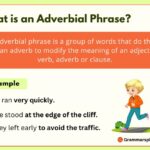
An adverbial phrase is a group of words that tell how, when, where, or why something happens.
Example Sentences:
He completed the project with great care.
They arrived in the middle of the night.
The children ran across the playground.
We will meet after the movie ends.
Identification of Adverbial Phrase
To identify an adverbial phrase in a sentence, look for a group of words that gives more information about the verb or another element. Adverbial phrases can often be recognized by answering one of the following questions:
| Question | Example Phrase |
|---|---|
| How? | in a relaxed manner |
| When? | after the meeting |
| Where? | at the park |
| Why? | because of the rain |
In the sentence He left the party early in the evening, the phrase early in the evening answers the question when? and modifies the verb left.
Usage of Adverbial Phrase
Adverbial phrases are used to provide more detailed information about the verb, adjective, or adverb in a sentence. They help to clarify how, when, where, why, or to what extent something happens. Here’s how adverbial phrases are used in sentences:
1. To Describe How an Action Occurs:
Adverbial phrases are used to describe how an action occurs. They modify verbs and provide additional information about the manner, way, or method in which something is done.
She sang with great emotion.
(The phrase with great emotion describes how she sang.)
2. To Indicate When an Action Happen:
Adverbial phrases can also be used to indicate when an action happens. They modify verbs and provide additional information about the time or frequency of an event.
- He will arrive in the afternoon.
(In the afternoon tells us when he will arrive.)
3. To Explain Where an Action Takes Place:
Adverbial phrases can also be used to explain where an action takes place. They modify verbs and provide additional information about the location of an event.
- They met at the park.
(The phrase at the park shows where they met.)
4. To Clarify Why an Action Happens:
Adverbial phrases can also be used to clarify why an action happens. They modify verbs and provide additional information about the reason or purpose of an event.
- She apologized for being late.
(For being late tells us why she apologized.)
5. To Show To What Extent an Action Occurs:
Adverbial phrases can also be used to show to what extent an action occurs. They modify verbs and provide additional information about the degree or intensity of an event.
- He ran so fast.
(So fast describes to what extent he ran.)
How to Form an Adverbial Phrase?
An adverbial phrase is a group of words that functions as an adverb, modifying a verb, an adjective, or another adverb. It often answers questions like how, when, where, or why something happens.
Unlike a single adverb, an adverbial phrase consists of multiple words working together.
Steps to Form an Adverbial Phrase
1. Start with an Adverb, Preposition, or Conjunction
An adverbial phrase can begin with an adverb, a preposition, or a subordinating conjunction.
- Adverb: She works very quickly.
- Preposition: He sat in the garden.
- Conjunction: I will call you after the meeting.
2. Add Modifiers or Complementary Words
Modifiers such as adjectives, nouns, or determiners can add detail to the phrase.
- She performed with great enthusiasm.
- They traveled to the farthest city.
3. Ensure It Answers a Question About the Verb
The phrase should clarify how, when, where, or why the action happens.
- When? I will arrive in an hour.
- How? He spoke with confidence.
4. Keep It Concise
Ensure the phrase is clear and directly related to the sentence. Avoid unnecessary words that do not contribute to the meaning.
Types Of Adverbial Phrase
Adverbial phrases can be categorized based on what they describe or modify in a sentence. Here are the main types of adverbial phrases:
1. Adverbial Phrases of Manner (How an action is done)
how an action is done.
These describe how an action is performed.
- She sings with passion.
- He spoke in a soft voice.
- They danced with grace.
2. Adverbial Phrases of Time (When an action happens)
when an action happens.
These specify when or how often an action occurs.
- We will meet in the evening.
- He visited the museum on Monday.
- She wakes up at sunrise.
3. Adverbial Phrases of Place (Where an action occurs)
where an action occurs.
These indicate where an action takes place.
- They went to the beach.
- The children played in the garden.
- She lives near the station.
4. Adverbial Phrases of Reason (Why an action happens)
These describe why something happens.
- He practices every day.
- They go to the gym twice a week.
- She visits her grandmother once a month.
5. Adverbial Phrases of Frequency (How often an action occurs)
These describe how frequently something happens.
- She studies for the exam.
- He left to catch the bus.
- They met to discuss the project.
6. Adverbial Phrases of Degree ( to what extent an action happens)
These adverbial phrases show to what extent or how much an action is done. They help express the intensity or magnitude of an action.
- She was so tired after the trip.
- He spoke quite loudly.
- The book is extremely interesting.
7. Adverbial Phrases of Condition (describing a condition of an action)
These phrases describe the condition under which an action takes place, often providing context for when or how something happens.
- He will succeed if he works hard.
- You can join the team as long as you follow the rules.
- She will go provided that the weather improves.

Adverb vs. Adverbial Phrase
Both adverbs and adverbial phrases modify verbs, adjectives, or other adverbs, but there are key differences between them. Here’s a comparison to help understand each one:
Adverb:
An adverb is a single word that modifies a verb, adjective, or another adverb. It answers questions like how, when, where, why, or to what extent.
Examples of Adverbs:
- She ran quickly.
- He is very tall.
- She is standing here.
- I always wake up early.
- He plays the piano well.
Adverbial Phrase:
An adverbial phrase is a group of two or more words that work together to modify a verb, adjective, or another adverb. It provides more detailed information and answers the same questions as adverbs, such as how, when, where, why, or to what extent.
Examples of Adverbial Phrases:
- For no reason: He left for no reason.
- With great care: She painted the picture with great care.
- In the morning: I usually exercise in the morning.
- At full speed: He ran at full speed.
Difference Between Adverb Phrases and Adverb Clauses
Adverb phrases and adverb clauses both function as modifiers in a sentence, providing additional information about a verb, adjective, or another adverb. However, they differ in structure and complexity.
1. Adverb Phrase
An adverb phrase is a group of words that work together as an adverb but do not contain a subject-verb pair.
Structure:
Contains an adverb as the main word, often combined with modifiers.
Function:
Modifies a verb, adjective, or another adverb by answering questions like how, when, where, or why.
Example Sentences:
- He ran very quickly. (How?)
- They stayed in the park. (Where?)
2. Adverb Clause
An adverb clause is a group of words that function as an adverb and contain both a subject and a verb.
Structure:
Begins with a subordinating conjunction (e.g., because, although, when) and includes a subject-verb pair.
Function:
Modifies a verb, adjective, or another adverb by answering questions like how, when, where, or why.
Example Sentences:
- He ran as if his life depended on it. (How?)
- They stayed because it started raining. (Why?)
Comparison Through Examples
How
- Adverb Phrase: She danced with elegance.
- Adverb Clause: She danced as though she were weightless.
When
- Adverb Phrase: He left before sunrise.
- Adverb Clause: He left before the sun rose.
Why
- Adverb Phrase: They stopped to take a rest.
- Adverb Clause: They stopped because they were tired.
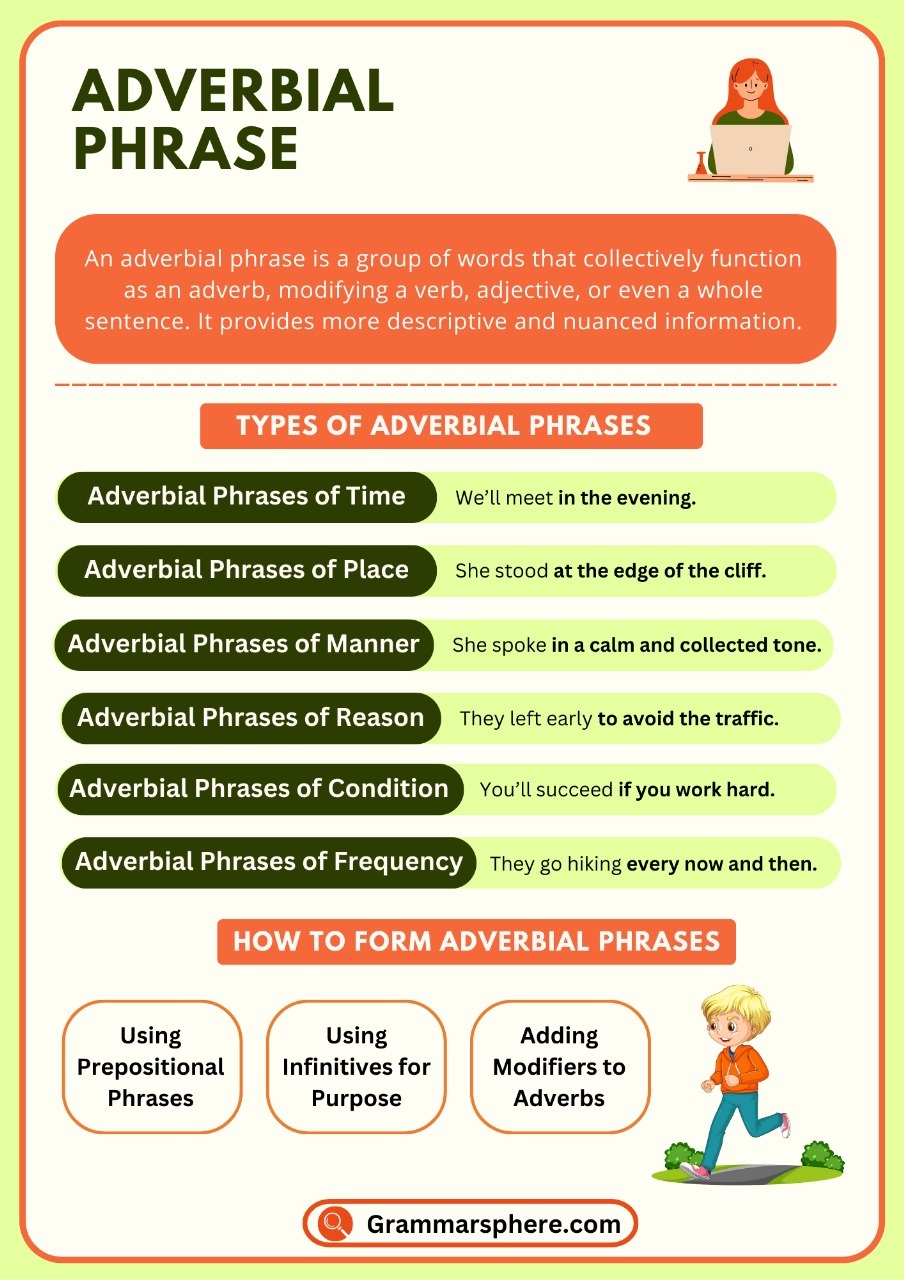
Examples of Adverbial Phrases
Here are some examples of sentences using adverbial phrases to modify verbs, adjectives, and other adverbs:
- She smiled with excitement when she saw the surprise.
- They walked in the rain without any umbrellas.
- He explained the situation with patience.
- I will call you in the morning.
- We went on a picnic by the lake.
- The cat hid under the bed when it heard the thunder.
- The children played in the garden all afternoon.
- She completed the task with ease.
- He was talking in a loud voice during the meeting.
- I found the book at the library.
- They finished the project on time.
- We will meet at the coffee shop later today.
- He apologized for being rude earlier.
- She danced with grace at the party.
- The teacher arrived before the bell rang.
These sentences demonstrate how adverbial phrases add detail by answering questions like how, when, where, why, or to what extent something happens.
Rules for Adverbial Phrase
Adverbial phrases enhance sentences by providing more information about how, when, where, why, or to what extent an action occurs. Here are the key rules for using adverbial phrases effectively:
1. Placement in Sentences:
Before the main verb:
If you want to emphasize the adverbial phrase, you can place it at the beginning of the sentence. When this happens, use a comma to separate the phrase from the main part of the sentence.
- With great enthusiasm, he started the project.
- In the early morning, they went for a jog.
After the main verb:
Most adverbial phrases appear after the main verb to provide additional detail. This is the most common placement for adverbial phrases.
- She speaks with clarity.
- They met at the cafe.
At the end of the sentence:
Adverbial phrases often come at the end of sentences, especially when they provide more specific details about the action.
- He works in a quiet environment.
- They arrived after the concert.
2. Adverbial Phrases with Prepositions:
Many adverbial phrases begin with a preposition (e.g., with, at, on, by, for, in, after) followed by a noun or pronoun.
- She sat on the bench.
- He spoke with confidence.
3. Use of Commas with Adverbial Phrases
When starting the sentence with an adverbial phrase, use a comma after it if it’s more than 3 words long or if it creates a pause.
- In the afternoon, we will leave.
- At the park, they had a picnic.
When the adverbial phrase appears at the end of the sentence, commas are usually not required, unless the phrase is very long or adds a nonessential detail.
- He finished the report in a hurry.
- She apologized for being late.
4. Modifying Verbs, Adjectives, or Other Adverbs:
Adverbial phrases modify verbs, adjectives, or other adverbs, providing more context or detail about the action or state being described.
- (verb): They walked with joy.
- (adjective): She is extremely talented.
- (adverb): He spoke so softly.
FAQS about Adverbial Phrase
What are adverbial phrases and examples?
An adverbial phrase is a group of words that works like an adverb, modifying a verb, adjective, or another adverb. It answers questions like how, when, where, or why.
Examples:
She sings with great passion (how).
He arrived after the meeting (when).
They sat under the tree (where).
What are the Types of Adverbial Phrase?
Adverbial Phrase of Time: Describes when something happens (e.g., after the event).
Adverbial Phrase of Place: Describes where something happens (e.g., in the garden).
Adverbial Phrase of Manner: Describes how something happens (e.g., with great effort).
Adverbial Phrase of Reason: Explains why something happens (e.g., to stay healthy).
What are the Functions of Adverbial Phrases?
Modify Verbs: Describe how, when, where, or why.
Example: She ran with great speed.
Indicate Purpose or Reason: Explain the reason for an action.
Example: He left early to catch the bus.
Show Time or Place: Clarify when or where something happens.
Example: We met after the meeting.
What is the difference between adverbial phrase and adverbial clause
Adverbial Phrase: A group of words without a subject-verb pair that acts as an adverb (e.g., with great care).
Adverbial Clause: A group of words with a subject-verb pair introduced by a subordinating conjunction (e.g., because she was late).
What are 5 examples of adverbial?
She ran with great speed.
We met after the show.
He waited in the car.
They stayed until midnight.
She spoke in a polite manner.
You May Also Like

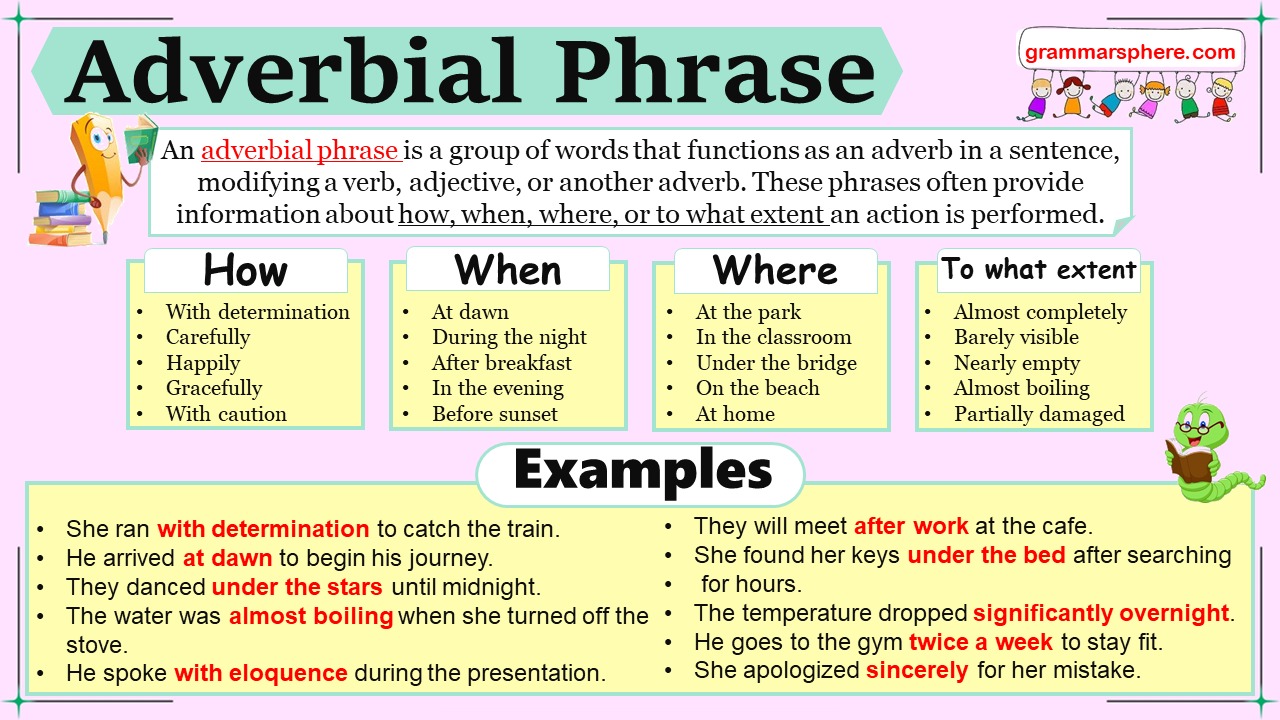
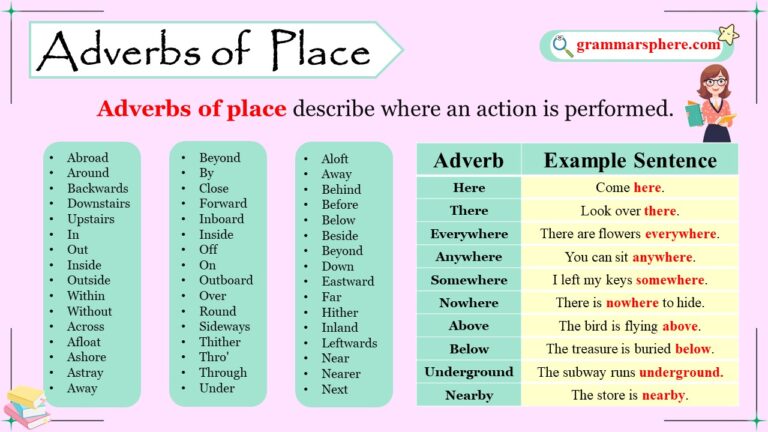
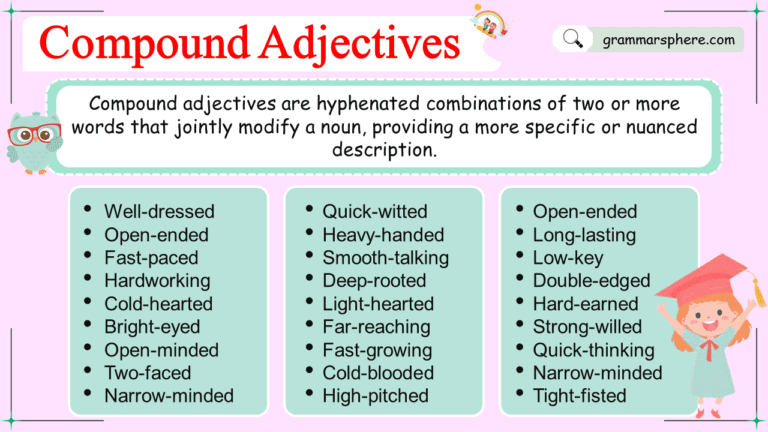
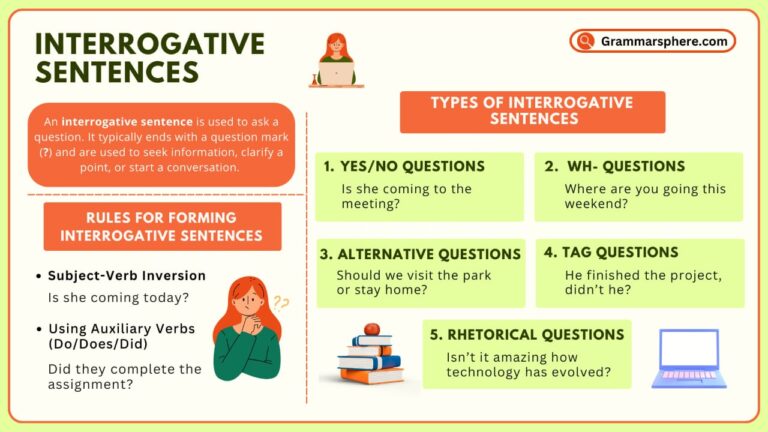


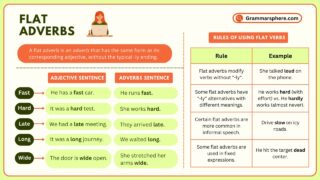
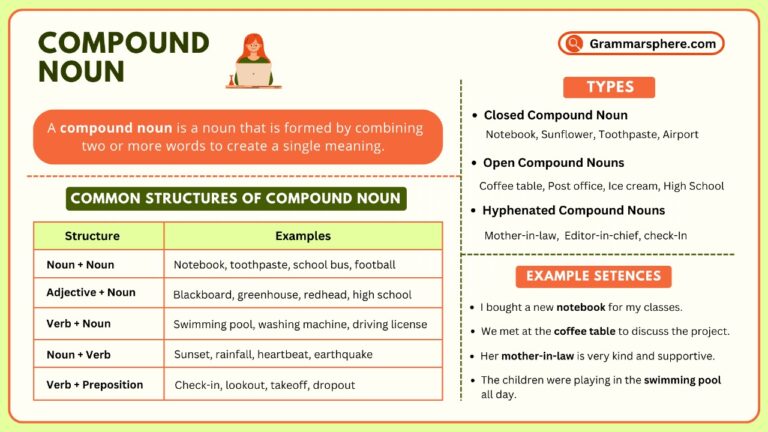
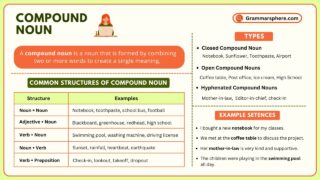
Leave a Comment